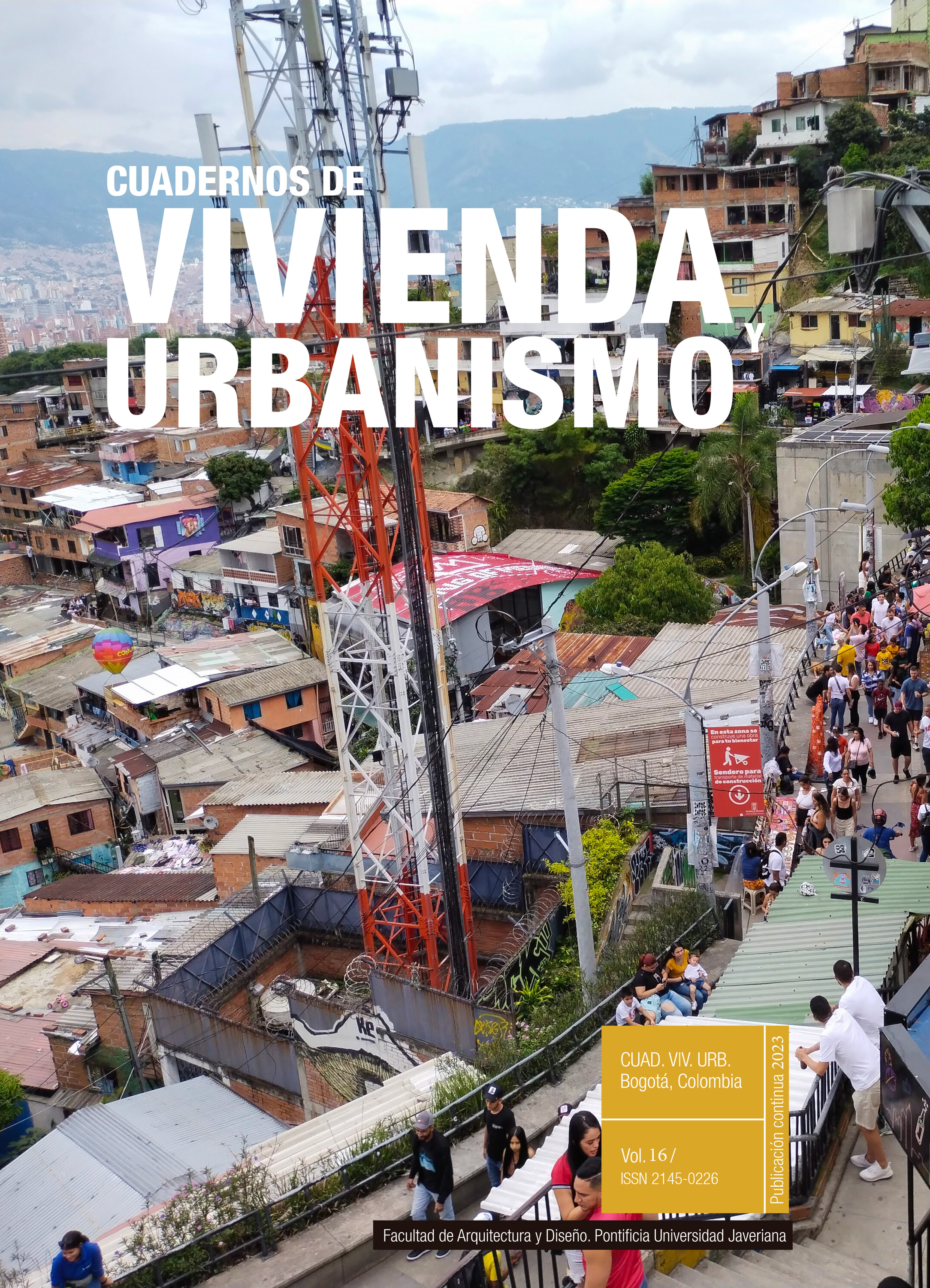Abstract
In order to know the value of real estate, it is necessary to perform an analysis of the factors that, according to the characteristics and particular conditions of each location, are the ones that determine the value. For this purpose, a novel method of real estate appraisal is developed that involves the Urban Interaction Factor that considers the location of the real estate and its contextual interaction, that is, the location influenced by the relativity between the value of the asset under study and the effect that the urban context has on it. After a market study of a representative sample of real estate in the metropolitan area of San Salvador, El Salvador, and applying the Urban Interaction Factor through geographic information systems software, a map of the city's land value is presented.
Alcaldía de San Salvador. (2022, 6 de mayo). Portal de la Alcaldía de San Salvador. Recuperado de http://www.sansalvador.gob.sv/
Anselin, L. (2003). Spatial Econometrics. En B. H. Baltagi (Ed.), A Companion to Theoretical Econometrics (pp. 310-330). Oxford: Blackwell Publishing Ltd. https://onlinelibrary.wiley.com/doi/book/10.1002/9780470996249
Ayola, D. P. (2012). Estimación del potencial de valorización del suelo en Barranquilla en el periodo 2001-2011. Revista de Economía del Caribe, (10), 65-91. http://www.scielo.org.co/scielo.php?script=sci_arttext&pid=S2011-21062012000200003
Baldor, A. (2014). Algebra (7a Ed.). New Jersey: Patria.
BCR. (2021). Norma NRP 27. San Salvador: Comité de Normas del Banco Central de la Reserva. https://www.bcr.gob.sv/regulaciones/upload/NRP-27.pdf
CNR. (2019). Geoportal Centro Nacional de Registros. San Salvador: CNR. Recuperado de cnr.gob.sv
Figueroa B., E. (1993). Estimaciones hedónicas del valor del mercado de los programas de vivienda social en la América Latina. El Trimestre Económico, 60(240(4)), 779–805. http://www.jstor.org/stable/45401618
Figueroa B. E. y Lever D. G. (1992). Determinantes del precio de la vivienda en Santiago: Una estimación hedónica. Estudios de Economía, 19 (1), 67-84. https://repositorio.uchile.cl/handle/2250/128244
Fitch Osuna, J. M, Soto Canales, K. y Garza Mendiola, R. (2011). Valuación de la producción y organización territorial. En N. Norte Pinto et al. (Eds.), Proceedings of the Seventh International Conference Virtual Cities and Territory (pp. 71-74). Lisboa: Nova University of Lisbon. https://doi.org/10.5821/ctv.7697
Geoportal OPAMSS. (2019, 2 de enero). Sistema de Información Metropolitano. San Salvador: COAMSS. Recuperado de https://opamss.org.sv/
Hernández Sampieri, R., Fernández Collado, C., y Baptista Lucio, P. (2014). Metodología de la Investigación (6a Ed.). México: McGrawHill.
IVSC. (2020). Normas Internacionales de Valuación. Londres: International Valuation Standards Council. https://www.fecoval.org.mx/leyes-normas-y-reglamentos/
Laurent, R. (2007). Propuesta de Aplicación del Factor de Comercialización en Costa Rica. Azimuth (1), 14-18. https://colegiotopografoscr.com/azimuth/revistas/revista/1.pdf
Laurent, R. (2010). Avalúos de inmuebles urbanos. Principios metodológicos. El Salvador: Cámara Salvadoreña de Valuación.
Lozano-Gracia, N. y Anselin, L. (2012). Is the price right?: Assessing estimates of cadastral values for Bogotá, Colombia, Regional Science Policy & Practice, 4(4), 495-508. http://dx.doi.org/10.1111/j.1757-7802.2012.01062.x
Lynch, K. (2008). La Imagen de la Ciudad. Barcelona: Editorial Gustavo Gili.
Martínez Moreno, R. y Sotelo Ahumada, H. (2021). Análisis de la valoración hedónica de la vivienda del Área Metropolitana de Monterrey. VinculaTégica, 7(2), 744-752. https://vinculategica.uanl.mx/index.php/v/article/view/139
Napier, J. (1889). The Construction of the Wonderful Canon of Logarithms. Edinburgh: W. Blackwood.
ONT. (2014). Guía Técnica Actualización de las Plataformas de Valores de Terrenos por Zonas Homogéneas. San Jose: Ministerio de Hacienda de Costa Rica. Recuperado el 5 de mayo de 2019, de https://www.hacienda.go.cr/docs/53f3714a144cd_guia%20tecnica.pdf
Perdomo, J. A. (2010). Una propuesta metodológica para estimar los cambios sobre el valor de la propiedad: estudio de caso para Bogotá aplicando Propensity Score Matching y Precios Hedónicos Espaciales. Lecturas de Economía, (73), 49-65. http://www.scielo.org.co/scielo.php?script=sci_arttext&pid=S0120-25962010000200002&lng=en&tlng=es.
QGIS.org. (2022, 6 de abril). QGIS Geographic Information System. QGIS Association. Recuperado de http://www.qgis.org
Ramírez Ospina, D. E. y Valencia Giraldo, L. (2013). Valoración hedónica de la vivienda. Una aplicación con variables ambientales. Apuntes del Cenes, 32(56), 139-174. http://www.scielo.org.co/scielo.php?script=sci_arttext&pid=S0120-30532013000200007&lng=en&tlng=es.
Revollo, D. A. (2009). Calidad de la vivienda a partir de la metodología de precios hedónicos para la Ciudad de Bogotá - Colombia. Revista Digital Universitaria de la Unam, 10 (7), 1-17. https://www.revista.unam.mx/vol.10/num7/art43/art43.pdf
Ridker, R. G. y Henning, J. A. (1967). The Determinants of Residential Property Values with Special Reference to Air Pollution. The Review of Economics and Statistics, 49(2), 246-257. https://doi.org/10.2307/1928231
Rosen, S. (1974). Hedonic Prices and Implicit Markets: Product Differentiation in Pure Competition. The Journal of Political Economy, 82 (1), 34-55. http://links.jstor.org/sici?sici=0022-3808%28197401%2F02%2982%3A1%3C34%3AHPAIMP%3E2.0.CO%3B2-U
Stumpf, M. y Torres, C. (1997). Estimación de Modelos de Precios Hedónicos para Alquileres Residenciales. Latin American Journal of Economics-antes Cuadernos de Economía. 34 (101), 71-86. http://www.economia.uc.cl/docs/101stuma.pdf
This journal is registered under a Creative Commons Attribution 4.0 International Public License. Thus, this work may be reproduced, distributed, and publicly shared in digital format, as long as the names of the authors and Pontificia Universidad Javeriana are acknowledged. Others are allowed to quote, adapt, transform, auto-archive, republish, and create based on this material, for any purpose (even commercial ones), provided the authorship is duly acknowledged, a link to the original work is provided, and it is specified if changes have been made. Pontificia Universidad Javeriana does not hold the rights of published works and the authors are solely responsible for the contents of their works; they keep the moral, intellectual, privacy, and publicity rights.
Approving the intervention of the work (review, copy-editing, translation, layout) and the following outreach, are granted through an use license and not through an assignment of rights. This means the journal and Pontificia Universidad Javeriana cannot be held responsible for any ethical malpractice by the authors. As a consequence of the protection granted by the use license, the journal is not required to publish recantations or modify information already published, unless the errata stems from the editorial management process. Publishing contents in this journal does not generate royalties for contributors.


